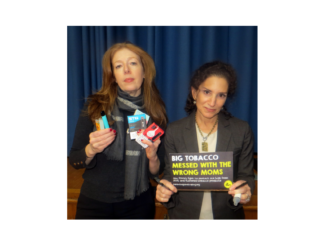
BY MICHAEL OLOHAN
OF NORTHERN VALLEY PRESS
As a federal agency looks to make it more difficult for teenagers to access electronic cigarettes—calling a recent jump in teenagers’ use of e-cigarettes “an epidemic”—area educators said existing disciplinary policies appeared to be acting as effective tools to limit any increase in local youths’ e-cigarette usage.
Most education officials surveyed said they did not observe any recent upticks in youth e-cigarette use, though they noted that e-cigarette use among minors is an ongoing concern.
U.S. Food and Drug Administration Administrator Scott Gottlieb announced Sept. 12 that youth vaping—specifically using electronic cigarettes—has reached an epidemic level in the United States and ordered the five major manufacturers to submit “robust plans” within 60 days to show what they are doing to prevent youths from accessing their products.
Gottlieb said nationwide more than 2 million college, high school and middle school students use electronic cigarettes—battery powered devices that heat liquid-based nicotine into vapor inhaled by its user. He said an estimated 12 percent of high school students and 3 percent of middle school students used an electronic smoking device within the last 30 days, according to the 2017 National Youth Tobacco Survey released in June.
Initially, electronic cigarettes were marketed, and still are, as an alternative for adults looking to reduce cigarette usage gradually and over the years, e-cigarette manufacturers have introduced multiple flavorings for e-cigarettes, making them attractive to adults and also teenagers.
As a federal agency looks to make it more difficult for teenagers to access electronic cigarettes—calling a recent jump in teenagers’ use of e-cigarettes “an epidemic”—area educators said existing disciplinary policies appeared to be acting as effective tools to limit any increase in local youths’ e-cigarette usage.
Most education officials surveyed said they did not observe any recent upticks in youth e-cigarette use, though they noted that e-cigarette use among minors is an ongoing concern.
U.S. Food and Drug Administration Administrator Scott Gottlieb announced Sept. 12 that youth vaping—specifically using electronic cigarettes—has reached an epidemic level in the United States and ordered the five major manufacturers to submit “robust plans” within 60 days to show what they are doing to prevent youths from accessing their products.
Gottlieb said nationwide more than 2 million college, high school and middle school students use electronic cigarettes—battery powered devices that heat liquid-based nicotine into vapor inhaled by its user. He said an estimated 12 percent of high school students and 3 percent of middle school students used an electronic smoking device within the last 30 days, according to the 2017 National Youth Tobacco Survey released in June.
Initially, electronic cigarettes were marketed, and still are, as an alternative for adults looking to reduce cigarette usage gradually and over the years, e-cigarette manufacturers have introduced multiple flavorings for e-cigarettes, making them attractive to adults and also teenagers.
“We sent letters to five e-cigarette manufacturers whose products were sold to kids during the enforcement blitz and that, collectively, represent more than 97 percent of the current market for e-cigs— JUUL, Vuse, MarkTen, blu e-cigs, and Logic,” said Gottlieb on Sept. 12. “These brands will be the initial focus of our attention when it comes to protecting kids.
“They’re now on notice by the FDA of how their products are being used by youth at disturbing rates. Let me be clear. This may require these brands to revise their sales and marketing practices, including online sales; to stop distributing their products to retailers who sell to kids; and to remove some or all of their flavored e-cig products from the market until they receive premarket authorization and otherwise meet applicable requirements,” continued Gottlieb.
‘Why kids are using’
Gottlieb said the FDA will investigate e-cigarette marketing practices, including inspections of retail outlets.
“The FDA is going to continue to work to find out why so many kids are using and abusing these products. And we’re not going to stop there,” said Gottlieb, noting the agency is re-examining enforcement discretion for e-cigarette products.
“The biggest youth use seems to be among cartridge-based e-cigarettes, and not the open-tank vaping products…our focus is on the products that are being misused by minors,” he added.
Gottlieb said increased scrutiny of retail and internet sales will occur.
“We’re also going to permanently step up our enforcement actions with a sustained campaign to monitor, penalize and prevent e-cig sales to minors in convenience stores and other retail sites. It’s clear there’s need for strong federal enforcement of youth access restrictions,” he noted.
“We’ll continue to hold retailers accountable by vigorously enforcing the law with the help of our state partners. The e-cig manufacturers ought to follow suit. They should also ensure that their online sales are not part of the problem,” Gottlieb warned.
Local vaping policies
Pascack Valley Regional High School District Superintendent P. Erik Gundersen said staff are trained annually on how to identify vaping devices and telltale signs to look for and assess whether a student is possibly under the influence of alcohol or drugs. Moreover, education about negative effects of smoking and drug use is ongoing.
“Educating students about the detrimental effects of cigarette smoking, vaping, alcohol, marijuana, prescription and illegal drugs has been and continues to be a priority for the Pascack Valley Regional High School District,” said Gundersen via email. “It is true from our experience that the trend among students who decide to experiment with smoking has shifted from traditional cigarette smoking to electronic vaping.”
But Gundersen said with the shift to electronic vaping, local administrators have another option should they suspect use of a controlled dangerous substance.
“The disciplinary consequences of student vaping is similar to that of cigarette smoking. However, the administration has the ability to send a student out for drug testing if there is reason to believe that the substance the student is using may contain THC, synthetic marijuana, and other illegal drugs,” Gundersen said.
Asked about student vaping consequences and a recent FDA national study that showed a 75 percent jump in high school students’ vaping, Gundersen said PVRHS district has been and will continue to be proactive.
“The Pascack Valley Regional High School District will continue to educate students, intervene if vaping devices are used, educate parents on what to look for, and work with local law enforcement to discourage our students from engaging in such dangerous behaviors,” he said.
While many schools have not adopted specific policies on vaping, most have included it under smoking and tobacco prohibitions.
At Emerson Junior/Senior High School, its student handbook described what’s prohibited, noting “possession and/or use of cigarettes, e-cigarettes, vape devices, smokeless tobacco, etc. by students in any school building, on school property, or at any school sponsored activity is prohibited and subject to disciplinary action.”
More severe disciplinary actions, including detentions and out-of-school suspensions are meted out for further violations, including infractions that focus on possession of electronic cigarettes and vape pens.
Northern Valley Regional High School District Superintendent James Santana said that the district updated its policy on vaping last year due to “issues with e-cigarette use. I see it as a challenge for all high schools and middle schools,” said Santana Sept. 20.
“We were faced with it, like other schools, so we tweaked our policy to address it,” Santana said.
Santana said students who are caught smoking an e-cigarette, or with e-cigarette paraphernalia, are immediately suspended for one day and sent for a drug test.
“It’s been effective since we put it in place,” he noted.
Santana said if a drug test is positive for controlled dangerous substances, a student is suspended for five days.
Santana said drug tests are required because school officials do not know what is in the liquids that e-cigarettes use to heat up and vaporize.
“A lot of the Juuls [an e-cigarette] and oils are not being regulated by the FDA and we have had some issues with it,” he said.
Santana said school officials were told by students that some liquid fill-ups for e-cigarettes—often purchased online—may contain THC, a psychoactive component of marijuana known to cause a “high” feeling.
Santana also noted that the lithium batteries that some e-cigarettes use to heat liquids have exploded or caused fires, creating an additional hazard. Asked about the FDA’s move to demand plans from manufacturers to keep e-cigarettes out of teenagers’ hands, Santana said “it would be sad if they really were targeting our kids” but was unsure how such products could be kept away from teenagers.
“The police, they’re not really sure how to handle this. Really, it’s a problem for everyone,” Santana said, adding that emails and notices on vaping have been sent to district parents.
‘Kid-friendly’ flavors
One of the FDA’s concerns has been what they termed “kid-friendly” flavors for e-cigarette nicotine products, which appear to be hooking youngsters on nicotine. Although vaping allegedly exposes users to less toxic chemicals than traditional smoking, the addictive component in vaping liquids is nicotine, which the FDA notes is available in larger amounts, with one cartridge or pod equal to the nicotine in a pack of cigarettes.
Flavors include a range of sweet additives such as mint, mango, coconut, and other tropical blends.
“We’re also announcing a national campaign to warn teenagers of the dangers of nicotine and e-cigarette use. This public campaign will bring these public health messages to online sites that we know teenagers access, and even to high school bathrooms,” said Gottlieb.
The campaign, called “The Real Cost,” began Sept. 19 and targets 10.7 million youngsters aged 12 to 17 who have used e-cigarettes. The FDA will place ads in 10,000 school bathrooms and websites, FDA officials said.
“I challenge e-cig manufacturers to take equally bold action to reform their own practices. There’s some historical advertising that I’ve seen, especially on social media, that gives me pause as to how earnest some of these companies were in making sure that kids didn’t use their products,” added Gottlieb.
Some social media contests apparently promoting e-cigarette use challenge teenagers to blow the biggest vapor cloud and make unique vapor shapes and post their efforts.
‘Regulatory consequences’
Gottlieb prodded the e-cigarette industry to prevent youth purchasing and potential addiction to nicotine-laced vapor products.
“Industry must step up to this challenge. The companies selling the brands that resulted in the most illegal sales in our enforcement blitz have 60 days to respond with forceful plans of their own or face regulatory consequences,”
“They say they’ve changed from the days of Joe Camel. But look at what’s happening right now, on our watch and on their watch. They must demonstrate that they’re truly committed to keeping these new products out of the hands of kids and they must find a way to reverse this trend,” he said.
In August 2016, the FDA announced that e-cigarettes would be regulated like other tobacco products. In New Jersey, the state raised the minimum age to purchase tobacco products to 21 last Nov. 1.


